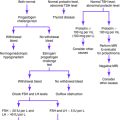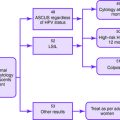Chapter 30 POSTPARTUM DEPRESSION
According to the Diagnostic and Statistical Manual of Mental Disorders, 4th edition, major depression is defined by the presence of five of the following symptoms, one of which must be either depressed mood or decreased interest or pleasure in activities:
• Depressed mood, often accompanied or overshadowed by severe anxiety
• Markedly diminished interest or pleasure in activities
• Appetite disturbance: usually loss of appetite with weight loss
• Sleep disturbance: most often insomnia and fragmented sleep (in new mothers, even when the baby sleeps)
• Physical agitation (most commonly) or psychomotor slowing
• Fatigue and decreased energy
• Feelings of worthlessness or excessive or inappropriate guilt
Postpartum psychosis occurs in 0.2% of childbearing women and usually begins during the first 4 weeks after delivery. The psychosis is typically manic in nature and in most cases may be considered a manifestation of bipolar disorder. Early warning signs include insomnia for several nights, agitation, an irritable or expansive mood, and avoidance of the infant. When delusions or hallucinations are present, they often involve the infant. Postpartum psychosis is considered a medical emergency because the affected woman is at risk for harming herself or her baby.
The Edinburgh Postnatal Depression Scale (Table 30-1) is a 10-item questionnaire that is an effective screening tool for postpartum depression. A cutoff score of 9 or 10 has been recommended as a reliable indicator for the presence of postpartum depression in women in the United States. A clinical interview to review symptoms and establish the diagnosis of depression is warranted. A score between 5 and 9 should be evaluated again 2 to 4 weeks later in order to determine whether an episode of depression has evolved or whether symptoms have subsided.
Table 30-1. Edinburgh Postnatal Depression Scale.
| Please circle the answer that best describes how you have felt over the past 7 days. |
(From Cox JL, Holden JM, Sagovsky R: Detection of postnatal depression: development of the 10-item Edinburgh Postnatal Depression Scale. Br J Psychiatry 1987;150:782-786)
Suggested Work-Up
| Thyroid-stimulating hormone (TSH) measurement | To evaluate for hypothyroidism or hyperthyroidism |
| Complete blood cell count (CBC) | To evaluate for anemia |
American Psychiatric Association. Diagnostic and Statistical Manual of Mental Disorders, 4th. Washington, DC: American Psychiatric Association, 1994.
Beck CT. Screening methods for postpartum depression. J Obstet Gynecol Neonatal Nurs. 1995;24:308-312.
Brockington I. Postpartum psychiatric disorders. Lancet. 2004;363:303-310.
Clay EC, Seehusen DA. A review of postpartum depression for the primary care physician. South Med J. 2004;97:157-161.
Cox JL, Holden JM, Sagovsky R. Detection of postnatal depression: development of the 10-item Edinburgh Postnatal Depression Scale. Br J Psychiatry. 1987;150:782-786.
Epperson CN. Postpartum major depression: detection and treatment. Am Fam Physician. 1999;59:2247-2254.
Miller LJ. Postpartum depression. JAMA. 2002;287:762-765.
Sharp LK, Lipsky MS. Screening for depression across the lifespan: a review of measures for use in primary care settings. Am Fam Physician. 2002;66:1001-1008.
Wisner KL, Parry BL, Piontek CM. Postpartum depression. N Engl J Med. 2002;347:194-199.




